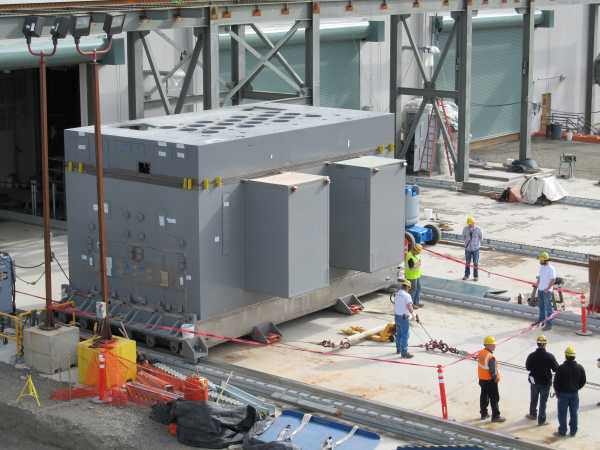Radioactive waste melters assembled inside Vit Plant
Key pieces of equipment that will be used to treat radioactive tank waste at the Hanford Site have now been safely and successfully assembled at the Hanford Vit Plant.
Construction on pace to deliver first major processing facility in 2018
RICHLAND, Wash. — Key pieces of equipment that will be used to treat radioactive tank waste at the Hanford Site have now been safely and successfully assembled at the Waste Treatment and Immobilization Plant (WTP) Low-Activity Waste (LAW) Facility.
The Department of Energy’s Office of River Protection (ORP) and WTP contractor Bechtel National Inc. (BNI) announced today the successful completion of assembly of the two nuclear waste melters, each at 300 tons, inside the LAW Facility.
“Assembling the melters is another indication we are completing the work necessary to achieve the Department’s Direct Feed Low-Activity Waste (DFLAW) approach to begin treating Hanford tank waste,” said Acting ORP Manager Ben Harp. “This approach will enable us to provide a more enduring means of protecting the Columbia River by starting treatment of the low-activity radioactive waste, the most mobile of the waste, as soon as 2022.”
Workers achieved assembly of the first melter in May, and finished the second in late August – both were accomplished ahead of schedule.
“With the melters assembled and all major process equipment already installed, our workforce remains on pace toward the construction complete contract milestone of June 2018 for the LAW Facility,” said Peggy McCullough, BNI project director for the WTP Project.
The melters, the largest of their kind ever built in the U.S., will be used to heat Hanford’s low-activity tank waste and glass-forming materials to 2,100 degrees Fahrenheit – a process called vitrification – before the mixture is poured into stainless steel containers for permanent storage. During plant operations, the LAW facility melters will produce 30 tons of glass daily, 10 times the capacity of the melter in operation at DOE Savannah River Site's Defense Waste Processing Facility in South Carolina.
The WTP LAW Facility is an integral component of the Department’s DFLAW approach, intended to begin treatment of Hanford tank waste as soon as 2022. Through DFLAW, DOE would begin to treat the low-activity waste portion as soon as the LAW facility, relevant support facilities and the WTP Analytical Laboratory are completed – in advance of completion of the entire WTP as was originally planned. This allows DOE to vitrify the waste as soon as possible, and provides valuable experience which will be beneficial when the entire plant is running. The lab is 98 percent complete, and the collection of more than 20 support facilities are largely complete – some portions of both the lab and support facilities are undergoing systems testing and startup activities.
About the Office of River Protection
The U.S. Department of Energy's (DOE) Hanford Site in southeast Washington state is home to 56 million gallons of chemical and radioactive waste stored in underground tanks – the result of more than four decades of plutonium production. The Office of River Protection (ORP) is responsible for the retrieval, treatment, and disposal of this waste in a safe, efficient manner. The River Protection Project is the largest and most complex environmental remediation project in the nation.
About Bechtel
Bechtel is designing and building the world’s largest radioactive waste treatment plant for the DOE at the Hanford Site in southeastern Washington state. The Waste Treatment and Immobilization Plant, also known as the Vit Plant, will immobilize the millions of gallons of radioactive liquid waste stored in 177 underground tanks using a process called vitrification. Visit www.hanfordvitplant.com.
###
High-Resolution Download: Right-click on a photo and select "Save Link As" or click on a photo to open a high-resolution version, then right-click the photo and select "Save Picture As."
One of two 300-ton melters installed in the Low-Activity Waste Facility
Aerial of the Low-Activity Waste (LAW) Facility. The LAW Facility will turn low-activity radioactive and chemical waste into glass to be permanently stored at Hanford.
One of two Low-Activity Waste Facility melters is pulled out of the building on rails for inspection. Bechtel National Inc., has safely assembled the melters that will be used to heat Hanford’s underground low-activity tank waste and glass-forming materials to 2,100 degrees Fahrenheit before the mixture is poured into stainless steel containers for permanent storage in a process called vitrification.






